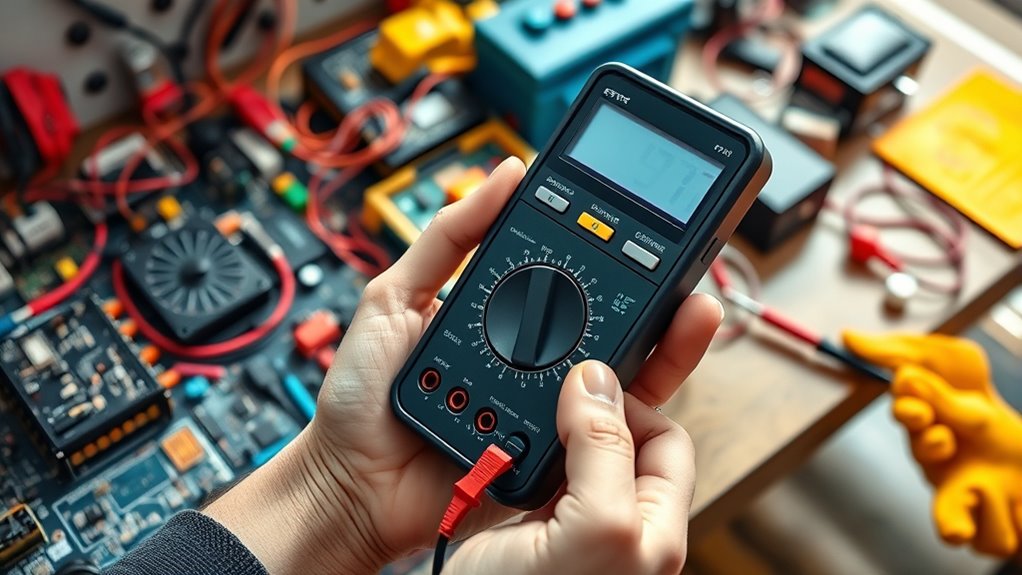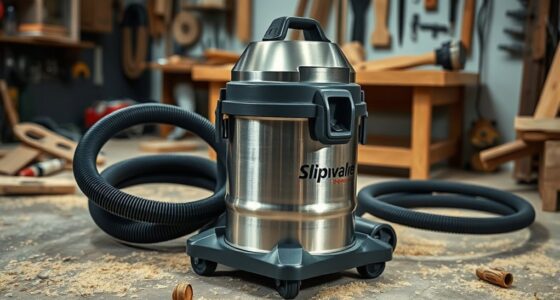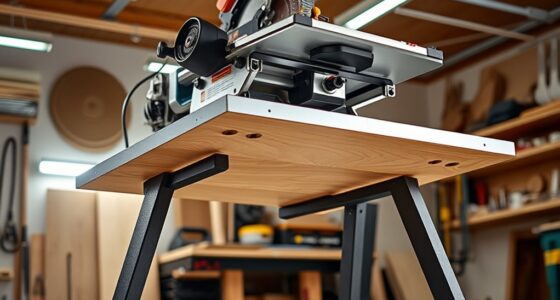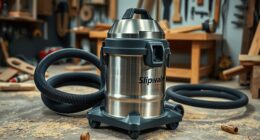To use a digital multimeter safely and effectively, start by setting it to the correct voltage, current, or resistance range. Always connect the black lead to ground or negative terminals, and the red lead to measurement points. Use insulated probes and avoid touching metal parts during tests. Verify settings before measurement and start with higher ranges if unsure. Proper techniques and safety precautions guarantee accurate results and prevent accidents—continue to explore for more detailed tips and tricks.
Key Takeaways
- Always set the multimeter to the correct voltage, current, or resistance range before measuring.
- Connect leads properly: black to ground/negative, red to measurement point, and switch to appropriate mode.
- Use insulated probes and avoid touching metal parts during measurements to ensure safety.
- Power off circuits when measuring resistance to prevent damage and inaccurate readings.
- Regularly calibrate your multimeter with certified standards to maintain measurement accuracy.
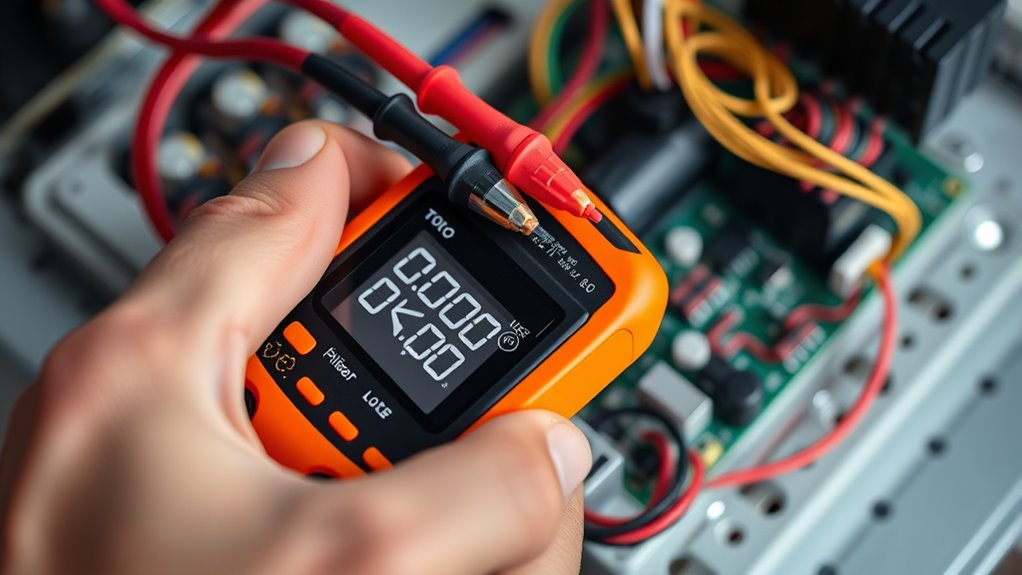
Have you ever wondered how to accurately measure voltage, current, or resistance in electronic circuits? Using a digital multimeter (DMM) can seem straightforward, but mastering its proper use requires understanding calibration techniques and troubleshooting methods. Calibration ensures your readings are precise, which is critical when diagnosing circuit problems or verifying component performance. Over time, a multimeter’s internal components can drift, leading to inaccurate measurements. To prevent this, you should regularly calibrate your device using known reference standards or calibration tools. Some multimeters have auto-calibration features, but many require manual adjustments. Checking your multimeter against a certified voltage or resistance source helps confirm it’s providing accurate data. If discrepancies appear, troubleshooting methods involve inspecting the leads for damage, ensuring proper contact, and verifying that the device’s settings are correct. Proper calibration is the foundation of reliable measurements, and troubleshooting helps identify when your multimeter might be giving faulty readings due to user error or hardware issues. Additionally, understanding the measurement ranges and their appropriate applications can help avoid common errors and improve accuracy.
When measuring voltage, you should set your multimeter to the appropriate DC or AC voltage range, depending on what you’re testing. Touch the black lead to the ground or negative terminal and the red lead to the point where you want to measure voltage. Remember, always start with the highest range if you’re unsure—this prevents damage to the meter and ensures safety. For current measurements, you’ll need to connect the multimeter in series with the circuit, often requiring you to switch the leads to the correct ports and change the device setting to current mode. Be cautious not to exceed the multimeter’s current limits to avoid blowing a fuse or damaging the device. Measuring resistance involves setting the multimeter to the resistance mode (Ω), and then touching the leads across the component or section of the circuit. Make sure the circuit is powered off before measuring resistance to avoid incorrect readings or damaging your multimeter.
Safety should always be your top priority. Use insulated probes, avoid touching metal parts when measuring live circuits, and ensure your multimeter is rated for the voltage and current levels you’ll encounter. Regularly inspecting the multimeter’s leads and connectors helps prevent unexpected shorts or faults. When troubleshooting, if your readings seem inconsistent or strange, double-check your connections, verify the calibration, and test the multimeter on a known good source. Knowing these calibration techniques and troubleshooting methods allows you to trust your measurements, avoid errors, and work safely with electronic circuits. With practice, you’ll develop a keen sense of how your multimeter behaves and how to interpret its readings accurately, ensuring your projects and repairs are both precise and safe.
Frequently Asked Questions
Can I Use a Digital Multimeter to Test Low-Voltage Circuits Safely?
Yes, you can use a digital multimeter to test low-voltage circuits safely. Just make certain you select the correct voltage range for accurate voltage testing, and always follow circuit safety precautions. Keep your hands steady and avoid touching exposed wires to prevent electrical shock. Using your multimeter properly helps you accurately diagnose issues while maintaining safety, especially when working with low-voltage circuits.
What Should I Do if My Multimeter Displays an Unusual Reading?
Like a modern-day Sherlock, when your multimeter shows an unusual reading, you should first double-check your connections and settings. Use multimeter troubleshooting techniques to verify if the probes are properly placed and the range is correct. If the reading remains abnormal, interpret it carefully—it might indicate a fault in the circuit or a multimeter issue. Always disconnect power before further testing and consult the device manual for guidance.
Is It Necessary to Calibrate My Digital Multimeter Regularly?
You should calibrate your digital multimeter regularly to guarantee accuracy. The calibration frequency depends on how often you use it and the precision required for your tasks. Regular calibration helps maintain accuracy, especially for critical measurements. Check the manufacturer’s recommendations and consider professional calibration if you notice inconsistent readings. Keeping your multimeter calibrated prevents errors and ensures reliable results during your testing and troubleshooting.
Can I Measure Capacitance With a Standard Multimeter?
Think of your multimeter as a versatile toolbox, but not all tools fit every job. You can measure capacitance with a standard multimeter, but only if it has a capacitance function, showing its capabilities. However, keep in mind the measurement limitations—some multimeters might not provide accurate readings for all capacitance ranges. Always verify your device’s specifications to confirm you’re using it within its capabilities for safe and reliable measurements.
How Do I Store My Multimeter to Ensure Longevity?
You should store your multimeter in a proper storage place, ideally inside a protective case, to prevent damage. Keep it in a cool, dry environment and avoid exposing it to extreme temperatures or humidity. Make sure to turn it off before storing, and remove the batteries if you won’t use it for a long time. Proper storage helps guarantee your multimeter stays accurate and lasts longer.
Conclusion
So, you’ve learned the essentials of using a digital multimeter—easy enough, right? Just remember, while it’s a handy tool, forgetting safety precautions can turn a simple task into a shocking experience. Irony strikes: the device that’s supposed to keep you safe might be your worst enemy if misused. So, stay alert, follow the basics, and don’t let your curiosity override caution. After all, a little safety goes a long way—especially when dealing with electricity!
